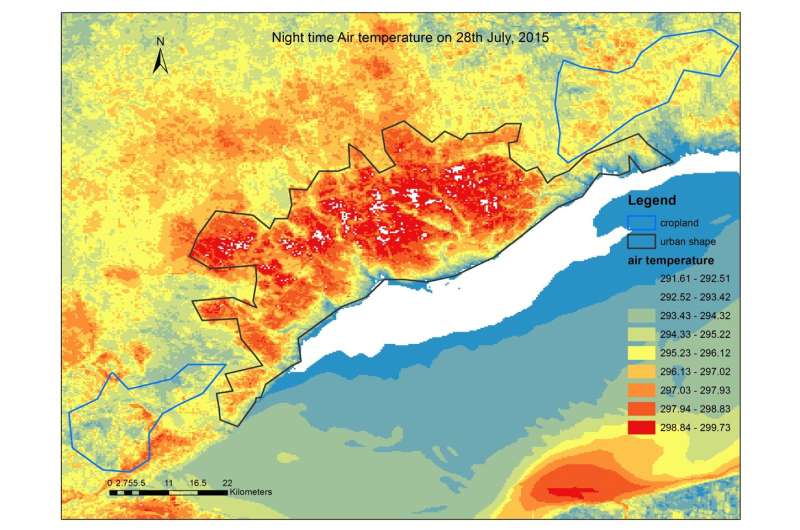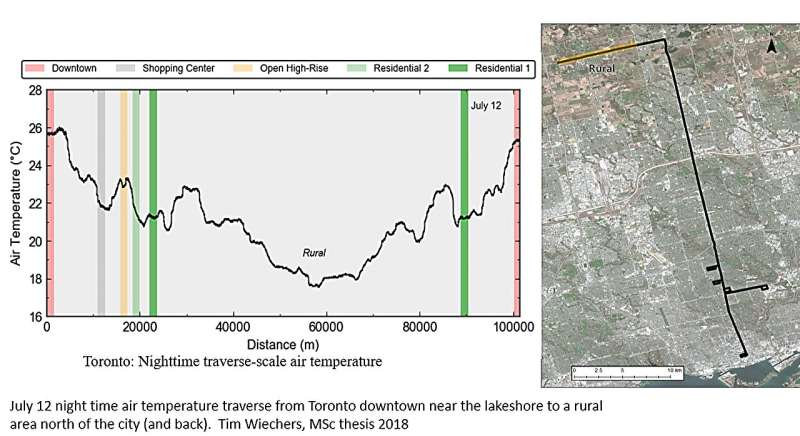This article has been reviewed according to Science X's editorial process and policies. Editors have highlighted the following attributes while ensuring the content's credibility:
fact-checked
trusted source
proofread
Expert explains how cities can beat the heat by building better

The United Nations recently declared that the world is now in an "era of global boiling."
An expert in urban climatology and urban heat islands (UHIs), geography and environment professor James Voogt spoke to Western News about the role UHIs play during extreme heat waves and what cities can do better to mitigate the extra heat they experience.
What is an urban heat island?
Urban heat island (UHI) is a term used to describe the relative warmth of urban areas compared to their rural surroundings. The relative warmth applies to air temperatures, surface temperatures and temperatures of the soil and substrate below the surface. Researchers define specific heat islands for each of those variables because the physical processes that control them are different.
The most common heat island is measured in the air. It is largest at night, when skies are clear, winds are calm and the surrounding rural area is relatively dry. Under those conditions the rural areas can cool quickly in the evening, while urban areas cool much more slowly, causing the temperature difference that defines the urban heat island. Under certain conditions, this heat island can be 10°C for a large city.
How are heat waves exacerbated in cities?
A heat wave in a city will be magnified relative to its non-urban surroundings. Research has shown some synergistic effects between heat waves and the UHI. There is some evidence that heat islands are enhanced during a heat wave. The physical mechanisms for these are still the subject of study. Positive feedback from waste heat due to increased air conditioner use is one, but contributions may include additional heat stored and then released at night by urban materials, and reduced moisture availability. That means that more of the absorbed energy from the sun is converted to heating the air.

Are there any consistent characteristics across different urban heat islands?
Daytime surface temperatures show much stronger spatial variability because dry surfaces exposed to the sun can become very hot (20 degrees C above air temperature) whereas those that are shaded or very moist are close to air temperature. Surface temperatures are therefore sensitive to shading, moisture and material characteristics (dark surfaces absorb more sun and become much hotter). At night surface and air temperatures tend to behave similarly.
There is some consistency in how similar neighborhoods in different cities will behave in terms of their temperature and UHI. However, an important consideration is a city's setting which plays an important role in the local climate and can alter the behavior of the urban-rural differences.
What are some of the dangers involved with this kind of heat we are seeing in city centers?
By day, hot urban surfaces and warmer air temperatures affect those working outside. At night, the urban heat island keeps minimum temperatures higher in cities. This can lead to lower sleep quality, which over time can have health impacts. Emissions of air pollutants and greenhouse gases can also rise during a heat wave if demand for energy to use to support air conditioning comes from fossil fuels.
Smog formation can increase during heat waves. Infrastructure is also impacted by excess heat: damage to pavements and bridges can occur, railway tracks can be deformed. There are impacts on power generation dependent on cooling water. There is impact on the longevity of electrical transformers. Excess demand for electricity could lead to brownouts or blackouts with serious consequences for the health of urban residents dependent on air conditioning.
What can we do to mitigate heat in urban areas?
At the scale of an individual building, there is a range of 'cool surface' technologies that can be used. A simple approach is to increase the reflectivity of a surface so it absorbs less sunlight. Green roofs also provide a cooling benefit. Shade, either naturally or constructed, provides for cooling below it.
At the neighborhood scale, vegetation is an important tool in combating heat. Trees provide cooling through both shade (cooling surface temperatures) and transpiration (cooling air temperatures). In dry climates, use of water can help in the summer season (ponds, fountains or misters). In more humid climates, it is important to provide ventilation corridors for air to flow into and through a neighborhood.
The city's topographic setting is also a consideration for mitigating heat. For coastal cities, daytime lake or sea breezes provide a potential cooling resource and in cities located in valleys or on slopes, cold air drainage that moves downslope at night can provide a resource for cooling in the summer.
Provided by University of Western Ontario




















